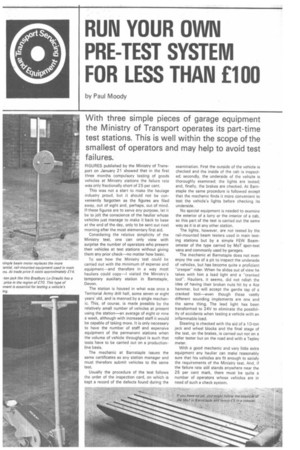RUN YOUR OWN PRE-TEST SYSTEM FOR LESS THAN OM
Page 77

If you've noticed an error in this article please click here to report it so we can fix it.
by Paul Moody
FIGURES published by the Ministry of Transport on January 21 showed that in the first three months compulsory testing of goods vehicles at Ministry stations the failure rate was only fractionally short of 25 per cent.
This was not a start to make the haulage industry proud, but it should not be conveniently forgotten as the figures are filed away, out of sight and, perhaps, out of mind. If-these figures are to serve any purpose, let it be to jolt the conscience of the haulier whose vehicles just manage to make it back to base at the end of the day, only to be sent out next morning after the most elementary first aid.
Considering the relative simplicity of the Ministry test, one can only view with surprise the number of operators who present their vehicles at test stations without giving them any prior check—no matter how basic.
To see how the Ministry test .could be carried out with the minimum of expense and equipment—and therefore in a way most hauliers could copy—I visited the Ministry's temporary auxiliary station in Barnstaple, Devon.
The station is housed in what was once a Territorial Army drill hall, some seven or eight years' old, and is manned by a single mechanic. This, of course, is made possible by the relatively small number of vehicles at present using the station—an average of eight or nine a week, although with increased staff it would be capable of taking more. It is only necessary to have the number of staff and expensive equipment of the permanent stations when the volume of vehicle throughput is such that tests have to be carried out on a productionline basis.
The mechanic at Barnstaple issues the same certificates as any station manager and must therefore submit vehicles to the same test.
Usually the procedure of the test follows the order of the inspection card, on which is kept a record of the defects found during the examination. First the outside of the vehicle is checked and the inside of the cab is inspected; secondly, the underside of the vehicle is thoroughly examined: the lights are tested: and, finally, the brakes are checked. At Barnstaple the same procedure is followed except that the mechanic finds it more convenient to test the vehicle's lights before checking its underside.
No special equipment is needed to examine the exterior of a lorry or the interior of a cab, so this part of the test is carried out the same way as it is at any other station.
The lights, however, are not tested by the rail-mounted beam testers used in main testing stations but by a simple FEW Beamometer of the type carried by MoT spot-test vans and commonly used by garages.
The mechanic at Barnstaple does not even enjoy the use of a pit to inspect the underside of vehicles, but has become quite a proficient "creeper" rider, When he slides out of view he takes with him a lead light and a "cranked tool". Hauliers, it seems, did not relish the idea of having their broken nuts hit by a 4oz hammer, but will accept the gentle tap of a cranked tool—even though these vastly different sounding implements are one and the same thing. The lead light has been transformed to 24V to eliminate the possibility of accidents when testing a vehicle with an inflammable load.
Steering is checked with the aid of a 10-ton jack and wheel blocks and the final stage of the test, on the brakes, is carried out not on a roller tester but on the road and with a Tapley meter.
With a good mechanic and very little extra equipment any haulier can make reasonably sure that his vehicles are fit enough to satisfy the requirements of the Ministry test. And, if the failure rate still stands anywhere near the 25 per cent mark, there must be quite a number of operators whose vehicles are in need of such a check system.












































































































































































